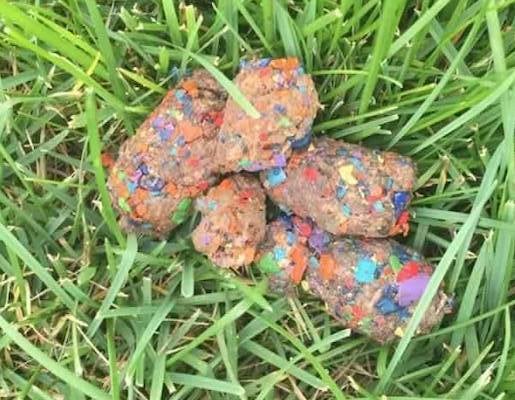 Whose Poop Is Whose?
Whose Poop Is Whose?
If you've got more than one dog or cat at home, odds are good that you've been faced with the "whose poop is this?" question at some point.
Whether you need to know because a pet is having diarrhea or because one of them is pooping on your carpets, figuring out which pet is having potty problems is always the first step to figuring out why.
Fortunately, there's a quick and easy trick to help you figure out whose poop is whose. While you could set up a webcam in the area or outside where your pet goes potty, there's a simpler way. It involves crayons!
The additional bonus of using this trick to figure out the pet with the tummy issues (in the case of diarrhea) is that you won’t have to take all your pets in to be seen by a veterinarian to pinpoint which one needs medical care.
You could save on a vet visit – at the very least, you won't have to bring all of your pets in to find out which one has the gastrointestinal issues – and possibly, you'll be able to help your pet at home.
See our tips for dealing with diarrhea in dogs and diarrhea tips for cats.
What You'll Need for This Crayon Tip
- Crayons – one color for each pet. Using bright colors is best, like turquoise blue, bright pink, etc. Yellow and orange could blend in too much, depending on the color of your pet's poop. And black, dark blue, and red may be harder to see.
Caution: Prior to selecting any brand of crayon, confirm the ingredients are safe. If not listed on the box, look up the Material Safety Data Sheet (MSDS) for that particular product. Also, search to see if that brand has had any safety recalls. - Your pet's food
An alternative to using crayons is food coloring (gel paste). Again, one color for each pet you're "testing."
Crayon Safety
Using crayons for this purpose is completely safe. Paraffin wax and color pigment are the two main ingredients for all Crayola Crayon colors (special effects crayons have some modifications). Per the MSDS sheet (Material Safety Data Sheet), the Art & Creative Material Institute has certified them as nontoxic. Using a small amount of crayon shavings is the key.
How to Feed Your Pets Crayons
- Using a vegetable peeler, make small shavings of the crayons — a different color for each pet.
- Mix a small amount of these shavings (about 1/8 tsp) into a small amount of wet food for each pet. You can also hide them in a pill pocket or pill paste, a large marshmallow (a vegan marshmallow is hypoallergenic), a "meatball" of bread or cheese (only if your pet is not lactose intolerant), or mix with peanut butter (xylitol-free) or Greek yogurt.
- Then, separate your pets while they each eat their "colorful little snack.”
- Watch to ensure that nobody is eating another's color, as this will mess up your experiment.
- Then keep an eye out for abnormal poops; the color of crayon in the poop will tell you whose it is!
If using food coloring: Use a small amount (5 drops for cats; 5–10 drops, depending on your dog's size) of concentrated gel paste food colorings (sometimes called icing colors).
One important note, if you choose to use the gel paste food colorings, is to read the label and make sure it doesn't contain xylitol. This sweetener is used in "sugar-free" items, so please read the label. At this time, we aren't aware of any brands that contain the sweetener, but they could be out there or could come on the market.
Some food coloring options that are safe for pets are:
Supernatural Plant-Based Food Coloring
Color Kitchen Plant-Base Food Coloring
Nutricolor Organic Blue Spirulina
Natural Liquid Food Coloring Set
McCormick Neon Assorted Food Colors & Egg Dye
If you want to make a natural food coloring, you can use strawberries, raspberries, blueberries, and others in this recipe using pet-friendly ingredients. But we haven't tried this, so we're not 100% positive it'll color your pet's poop enough, but if you're into baking for your pets, this could work! While it is a recipe for dogs, it's safe to use for cats as well.
NOTE about using craft glitter: Even though some zoos, like the one featured in the National Geographic video below, use glitter to identify poop in animals sharing living quarters, it isn't wise to use this method for your pets.
Never use glass glitter!!! Many of the "safe" glitter products we found came from eucalyptus, which can be toxic to pets. Glitter can easily be inhaled while eating, so it could end up in their lungs and nasal passageways.
This glitter is food-grade, so it appears to be safe for pets. But again, it's likely not worth the risk, and we haven't tried it personally to know whether it would be detectable in the stool.
Poop photo below: This"funfetti" poop wasn't the result of someone getting this tip horribly wrong. But rather, the colorful end result of a dog who ate a whole box of crayons! The dog was fine, and the family was certainly in no danger of accidentally stepping on it in the yard!

Solving the Poop Mystery
There are many reasons why a dog or cat may be having diarrhea or why they may be pooping indoors or outside the litter box.
Diarrhea can result from:
- Dietary indiscretion (i.e., eating or being fed things they shouldn't)
- Infectious causes (e.g., viral, bacterial, worms, and others)
- Hormonal conditions (e.g., hyperthyroidism in cats, Addison's disease, and others)
- Inflammatory reasons (e.g., inflammatory bowel disease, pancreatitis)
- Stress and anxiety
- And a host of other reasons
Defecating in the wrong place can also have a variety of causes, including:
- Arthritis (in dogs; in cats)
- Nervous system problems (incl. Canine Cognitive Dysfunction in dogs)
- Stress (read more about inappropriate elimination in cats)
- And many others
Questions? To chat with a veterinarian about your pet's diarrhea, Click here
Your veterinarian truly is your best resource for working through the potential causes of your pet's diarrhea or inappropriate defecation. If you have any questions about using crayons, leave us a comment below.




